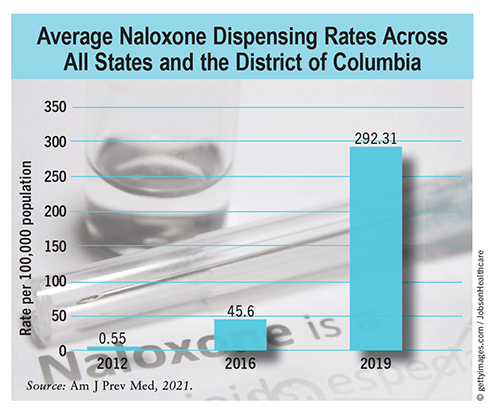US Pharm. 2023;48(3):14.
Over the past 2 decades, drug-overdose deaths have increased fivefold in the United States. In 2021, the age-adjusted rate of drug-overdose deaths was 32.4 per 100,000 population, with an increase from the previous year in both males and females (39.5 to 45.1 and 17.1 to 19.6, respectively). Between 2020 and 2021, the greatest percentage increases in rates occurred in adults aged 65 years and older and among non-Hispanic native Hawaiians or other Pacific Islanders.

Opioid Overdoses: According to the National Center for Health Statistics, more than 106,000 deaths occurred as a result of drug overdose in 2021. Of these deaths, 80,411 were due to opioid overdose—an increase from 68,630 in 2020 and 21,089 in 2010. The age-adjusted rate of overdose deaths involving natural and semisynthetic opioids increased from 1.2 to 4.0 per 100,000 population between 2001 and 2021, with similar rate increases for deaths involving synthetic opioids other than methadone. Therefore, improving access to naloxone (an opioid antagonist used to temporarily reverse the effects of an opioid overdose) has been an essential public-health strategy to help prevent fatal consequences of this opioid epidemic across the U.S.
Naloxone Trends: Average state-level naloxone dispensing rates increased from 0.55 to 292.31 per 100,000 population between 2012 and 2019. The average number of naloxone prescriptions per 100 high-dose opioid prescriptions also rose—from 0.002 to 3.04—during this time period across all states and the District of Columbia. In 2020, an abrupt reduction of 26.32% was seen in the average number of individuals filling naloxone prescriptions per week. This was attributed to the COVID-19 pandemic, during which prescriptions for opioids and any medication also decreased from 2019 (–8.71% and –14.76%, respectively). Persons with commercial insurance or Medicare had a significant decline in filling naloxone prescriptions during this time (–31.20% and –34.15%, respectively), whereas those without insurance or Medicaid had no statistically significant change.
Prescribing Mandates: Community education on naloxone and opioid overdose has been shown to reduce overdose deaths among community members; however, naloxone prescribing and dispensing rates remain relatively low, with substantial variations nationwide (1.04 to 16.64 naloxone prescriptions dispensed per 100 high-dose opioid prescriptions in 2019). The CDC and the FDA recommend that healthcare professionals (HCPs) discuss naloxone availability with all patients prescribed opioid agonists for pain management or treatment of opioid use disorder (OUD) and those at increased risk for opioid overdose (e.g., previous opioid overdose, history of OUD, concomitant benzodiazepine use). Eleven states currently have regulations requiring certain HCPs to prescribe or offer a prescription for naloxone to patients meeting criteria for increased opioid-overdose risk. Additionally, all states and the District of Columbia have some form of a standing order for pharmacists to dispense naloxone under naloxone-access laws.
The content contained in this article is for informational purposes only. The content is not intended to be a substitute for professional advice. Reliance on any information provided in this article is solely at your own risk.
To comment on this article, contact rdavidson@uspharmacist.com.






